

Compact Muon Solenoid
LHC, CERN
| CMS-EXO-17-009 ; CERN-EP-2018-265 | ||
| Search for pair production of first-generation scalar leptoquarks at $\sqrt{s} = $ 13 TeV | ||
| CMS Collaboration | ||
| 3 November 2018 | ||
| Phys. Rev. D 99 (2019) 052002 | ||
| Abstract: A search for the pair production of first-generation scalar leptoquarks is performed using proton-proton collision data recorded at 13 TeV center-of-mass energy with the CMS detector at the LHC. The data correspond to an integrated luminosity of 35.9 fb$^{-1}$. The leptoquarks are assumed to decay promptly to a quark and either an electron or a neutrino, with branching fractions $\beta$ and $ 1{-}\beta $, respectively. The search targets the decay final states comprising two electrons, or one electron and large missing transverse momentum, along with two quarks that are detected as hadronic jets. First-generation scalar leptoquarks with masses below 1435 (1270) GeV are excluded for $\beta =$ 1.0 (0.5). These are the most stringent limits on the mass of first-generation scalar leptoquarks to date. The data are also interpreted to set exclusion limits in the context of an $R$-parity violating supersymmetric model, predicting promptly decaying top squarks with a similar dielectron final state. | ||
| Links: e-print arXiv:1811.01197 [hep-ex] (PDF) ; CDS record ; inSPIRE record ; CADI line (restricted) ; | ||
| Figures | |
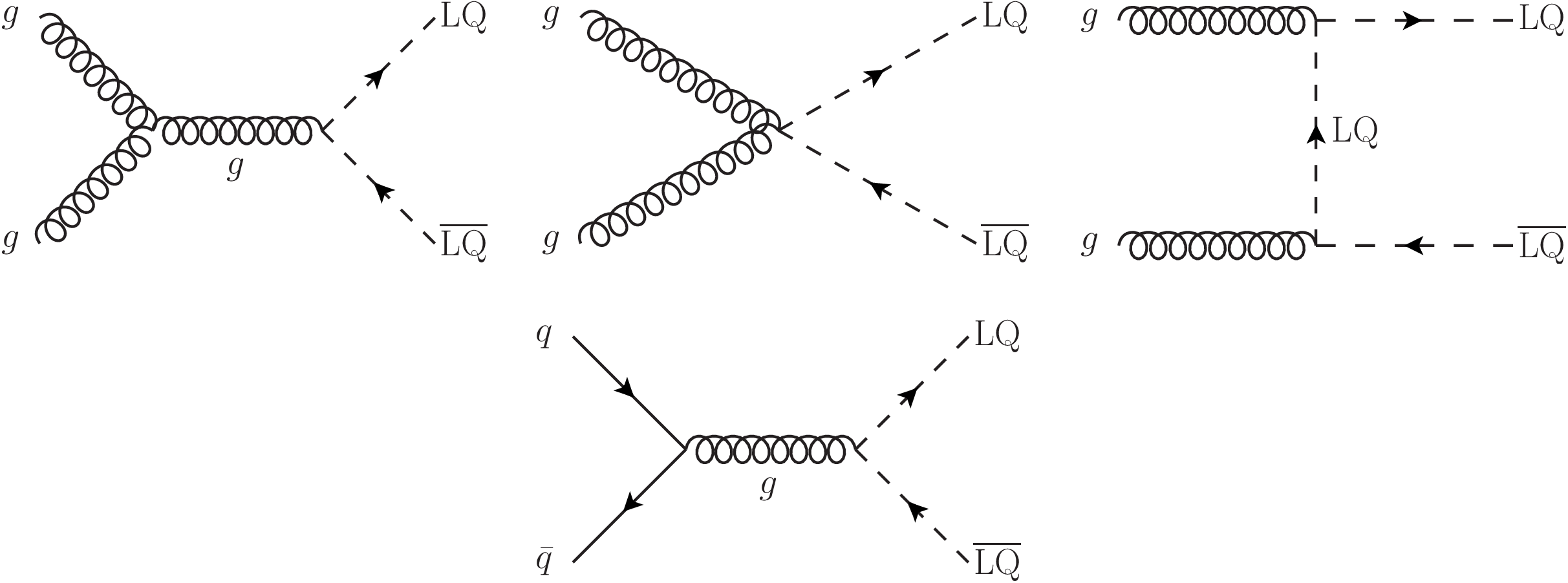
png pdf |
Figure 1:
Leading order Feynman diagrams for the scalar LQ pair production channels at the LHC. |
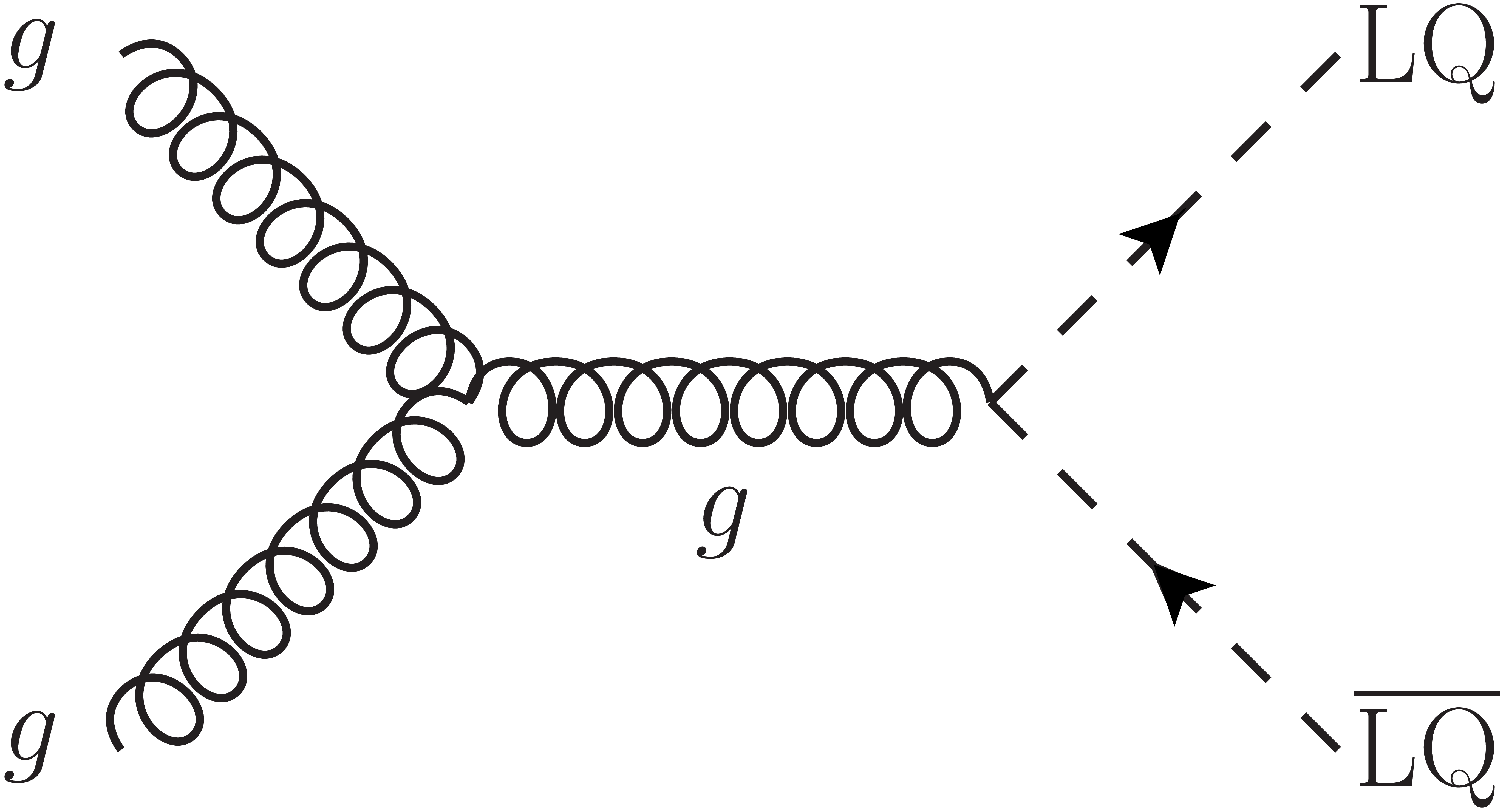
png pdf |
Figure 1-a:
Leading order Feynman diagram for the scalar LQ pair production at the LHC. |

png pdf |
Figure 1-b:
Leading order Feynman diagram for the scalar LQ pair production at the LHC. |

png pdf |
Figure 1-c:
Leading order Feynman diagram for the scalar LQ pair production at the LHC. |

png pdf |
Figure 1-d:
Leading order Feynman diagram for the scalar LQ pair production at the LHC. |
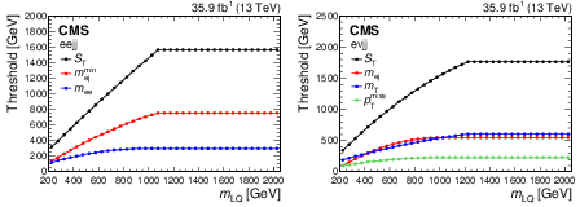
png pdf |
Figure 2:
Optimized threshold values applied for the selection variables in the $ {{\mathrm {e}} {\mathrm {e}}\text {jj}} $ (left) and $ {{\mathrm {e}} {\nu}\text {jj}} $ (right) channels as a function of $ {m_{\text {LQ}}} $. |

png pdf |
Figure 2-a:
Optimized threshold values applied for the selection variables in the $ {{\mathrm {e}} {\mathrm {e}}\text {jj}} $ channel as a function of $ {m_{\text {LQ}}} $. |

png pdf |
Figure 2-b:
Optimized threshold values applied for the selection variables in the $ {{\mathrm {e}} {\nu}\text {jj}} $ channel as a function of $ {m_{\text {LQ}}} $. |

png pdf |
Figure 3:
Data and background comparison for events passing the initial selection requirements for the $ {{\mathrm {e}} {\mathrm {e}}\text {jj}} $ channel, shown for the variables used for final selection optimization: $ {m_{{\mathrm {e}} {\mathrm {e}}}} $ (upper), $ {m_{{\mathrm {e}}\text {j}}^\text {min}} $ (lower left), and $ {S_{\mathrm {T}}} $ (lower right). "Other background" includes diboson, single top quark, and W+jets. Signal predictions for $ {m_{\text {LQ}}} = $ 650 and 1200 GeV hypotheses are overlaid on the plots. The last bin includes all events beyond the upper $x$-axis boundary. |
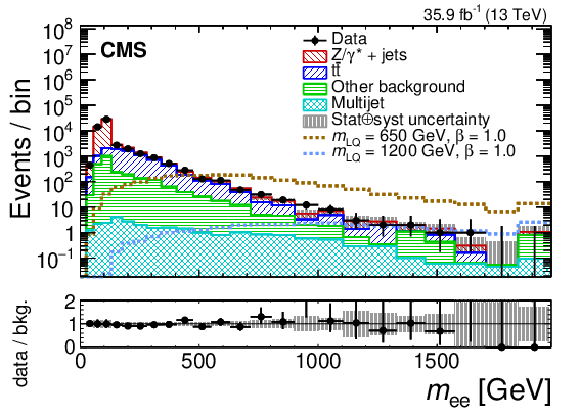
png pdf |
Figure 3-a:
Data and background comparison for events passing the initial selection requirements for the $ {{\mathrm {e}} {\mathrm {e}}\text {jj}} $ channel, shown for the $ {m_{{\mathrm {e}} {\mathrm {e}}}} $ variable. "Other background" includes diboson, single top quark, and W+jets. Signal predictions for $ {m_{\text {LQ}}} = $ 650 and 1200 GeV hypotheses are overlaid on the plot. The last bin includes all events beyond the upper $x$-axis boundary. |

png pdf |
Figure 3-b:
Data and background comparison for events passing the initial selection requirements for the $ {{\mathrm {e}} {\mathrm {e}}\text {jj}} $ channel, shown for the $ {m_{{\mathrm {e}}\text {j}}^\text {min}} $ variable. "Other background" includes diboson, single top quark, and W+jets. Signal predictions for $ {m_{\text {LQ}}} = $ 650 and 1200 GeV hypotheses are overlaid on the plot. The last bin includes all events beyond the upper $x$-axis boundary. |
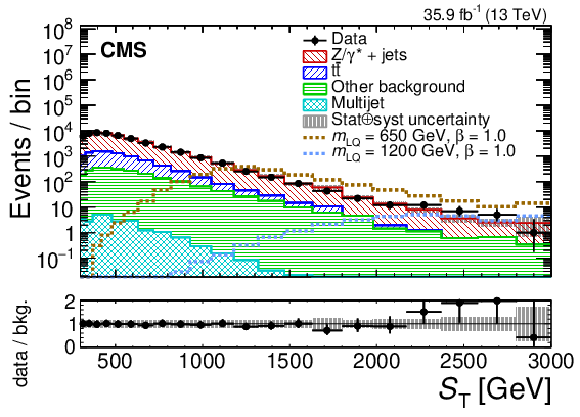
png pdf |
Figure 3-c:
Data and background comparison for events passing the initial selection requirements for the $ {{\mathrm {e}} {\mathrm {e}}\text {jj}} $ channel, shown for the $ {S_{\mathrm {T}}} $ variable. "Other background" includes diboson, single top quark, and W+jets. Signal predictions for $ {m_{\text {LQ}}} = $ 650 and 1200 GeV hypotheses are overlaid on the plot. The last bin includes all events beyond the upper $x$-axis boundary. |
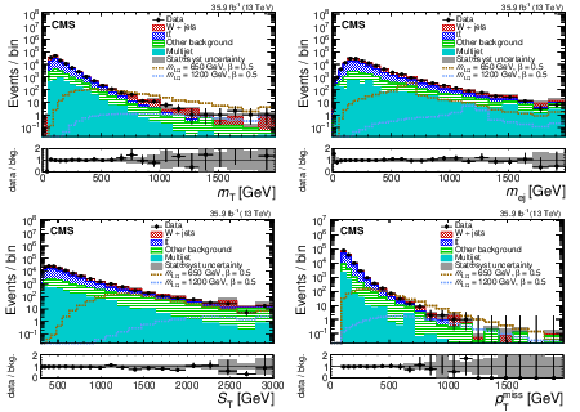
png pdf |
Figure 4:
Data and background for events passing the initial selection requirements in the $ {{\mathrm {e}} {\nu}\text {jj}} $ channel, shown for the variables used for final selection optimization: $ {m_{\mathrm {T}}} $ (upper left), $ {m_{{\mathrm {e}}\text {j}}} $ (upper right), $ {S_{\mathrm {T}}} $ (lower left), and $ {{p_{\mathrm {T}}} ^\text {miss}} $ (lower right). "Other background" includes diboson, single top quark, and Z/$\gamma^{*}$+jets. Signal predictions for $ {m_{\text {LQ}}} = $ 650 and 1200 GeV hypotheses are overlaid on the plots. The last bin includes all events beyond the upper $x$-axis boundary. |

png pdf |
Figure 4-a:
Data and background for events passing the initial selection requirements in the $ {{\mathrm {e}} {\nu}\text {jj}} $ channel, shown for the $ {m_{\mathrm {T}}} $ variable. "Other background" includes diboson, single top quark, and Z/$\gamma^{*}$+jets. Signal predictions for $ {m_{\text {LQ}}} = $ 650 and 1200 GeV hypotheses are overlaid on the plot. The last bin includes all events beyond the upper $x$-axis boundary. |
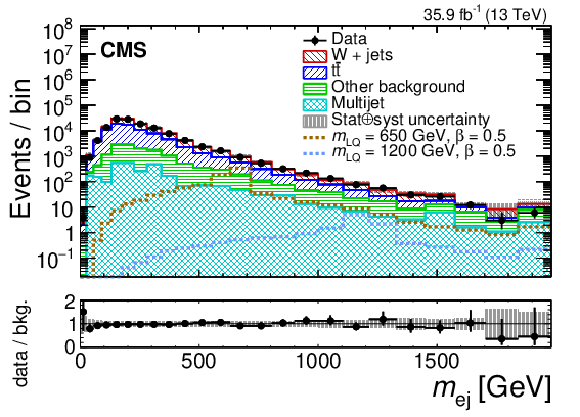
png pdf |
Figure 4-b:
Data and background for events passing the initial selection requirements in the $ {{\mathrm {e}} {\nu}\text {jj}} $ channel, shown for the $ {m_{{\mathrm {e}}\text {j}}} $ variable. "Other background" includes diboson, single top quark, and Z/$\gamma^{*}$+jets. Signal predictions for $ {m_{\text {LQ}}} = $ 650 and 1200 GeV hypotheses are overlaid on the plot. The last bin includes all events beyond the upper $x$-axis boundary. |
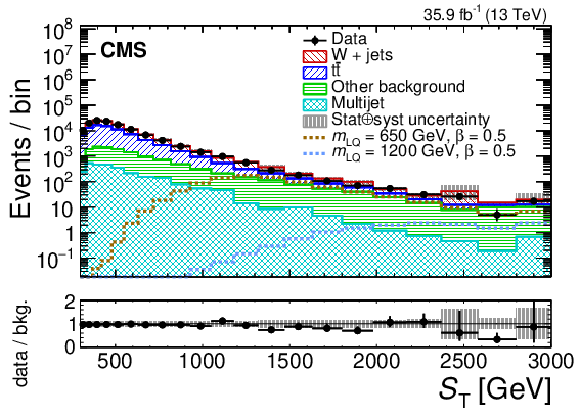
png pdf |
Figure 4-c:
Data and background for events passing the initial selection requirements in the $ {{\mathrm {e}} {\nu}\text {jj}} $ channel, shown for the $ {S_{\mathrm {T}}} $ variable. "Other background" includes diboson, single top quark, and Z/$\gamma^{*}$+jets. Signal predictions for $ {m_{\text {LQ}}} = $ 650 and 1200 GeV hypotheses are overlaid on the plot. The last bin includes all events beyond the upper $x$-axis boundary. |
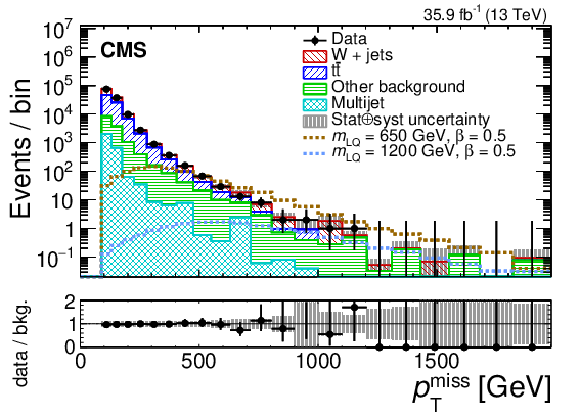
png pdf |
Figure 4-d:
Data and background for events passing the initial selection requirements in the $ {{\mathrm {e}} {\nu}\text {jj}} $ channel, shown for the $ {{p_{\mathrm {T}}} ^\text {miss}} $ variable. "Other background" includes diboson, single top quark, and Z/$\gamma^{*}$+jets. Signal predictions for $ {m_{\text {LQ}}} = $ 650 and 1200 GeV hypotheses are overlaid on the plot. The last bin includes all events beyond the upper $x$-axis boundary. |

png pdf |
Figure 5:
$ {m_{{\mathrm {e}}\text {j}}^\text {min}} $ (left) and $ {S_{\mathrm {T}}} $ (right) distributions for events passing the $ {{\mathrm {e}} {\mathrm {e}}\text {jj}} $ final selection for LQs of mass 650 (upper) and 1200 (lower) GeV. The predicted signal model distributions are shown, along with major backgrounds and "other background'' which consists of the sum of the W+jets, diboson, single top quark, and $\gamma$+jets contributions. The background contributions are stacked, while the signal distributions are plotted unstacked. The dark shaded region indicates the statistical and systematic uncertainty in the total background. The last bin includes all events beyond the upper $x$-axis boundary. |

png pdf |
Figure 5-a:
$ {m_{{\mathrm {e}}\text {j}}^\text {min}} $ distribution for events passing the $ {{\mathrm {e}} {\mathrm {e}}\text {jj}} $ final selection for LQs of mass 650 GeV. The predicted signal model distribution is shown, along with major backgrounds and "other background'' which consists of the sum of the W+jets, diboson, single top quark, and $\gamma$+jets contributions. The background contributions are stacked, while the signal distribution is plotted unstacked. The dark shaded region indicates the statistical and systematic uncertainty in the total background. The last bin includes all events beyond the upper $x$-axis boundary. |

png pdf |
Figure 5-b:
$ {S_{\mathrm {T}}} $ distribution for events passing the $ {{\mathrm {e}} {\mathrm {e}}\text {jj}} $ final selection for LQs of mass 650 GeV. The predicted signal model distribution is shown, along with major backgrounds and "other background'' which consists of the sum of the W+jets, diboson, single top quark, and $\gamma$+jets contributions. The background contributions are stacked, while the signal distribution is plotted unstacked. The dark shaded region indicates the statistical and systematic uncertainty in the total background. The last bin includes all events beyond the upper $x$-axis boundary. |

png pdf |
Figure 5-c:
$ {m_{{\mathrm {e}}\text {j}}^\text {min}} $ distribution for events passing the $ {{\mathrm {e}} {\mathrm {e}}\text {jj}} $ final selection for LQs of mass 1200 GeV. The predicted signal model distribution is shown, along with major backgrounds and "other background'' which consists of the sum of the W+jets, diboson, single top quark, and $\gamma$+jets contributions. The background contributions are stacked, while the signal distribution is plotted unstacked. The dark shaded region indicates the statistical and systematic uncertainty in the total background. The last bin includes all events beyond the upper $x$-axis boundary. |

png pdf |
Figure 5-d:
$ {S_{\mathrm {T}}} $ distribution for events passing the $ {{\mathrm {e}} {\mathrm {e}}\text {jj}} $ final selection for LQs of mass 1200 GeV. The predicted signal model distribution is shown, along with major backgrounds and "other background'' which consists of the sum of the W+jets, diboson, single top quark, and $\gamma$+jets contributions. The background contributions are stacked, while the signal distribution is plotted unstacked. The dark shaded region indicates the statistical and systematic uncertainty in the total background. The last bin includes all events beyond the upper $x$-axis boundary. |
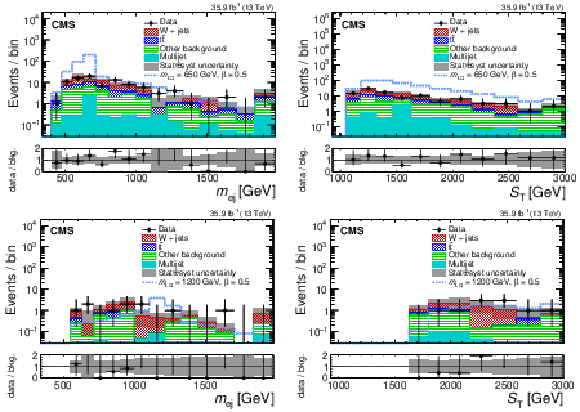
png pdf |
Figure 6:
$ {m_{{\mathrm {e}}\text {j}}} $ (left) and $ {S_{\mathrm {T}}} $ (right) distributions for events passing the $ {{\mathrm {e}} {\nu}\text {jj}} $ final selection for LQs of mass 650 (upper) and 1200 (lower) GeV. The predicted signal model distributions are shown, along with major backgrounds and "other background'' which consists of the sum of Z/$\gamma^{*}$+jets, diboson, single top quark, and $\gamma$+jets contributions. The background contributions are stacked, while the signal distributions are plotted unstacked. The dark shaded region indicates the statistical and systematic uncertainty in the total background. The last bin includes all events beyond the upper $x$-axis boundary. |

png pdf |
Figure 6-a:
$ {m_{{\mathrm {e}}\text {j}}} $ distribution for events passing the $ {{\mathrm {e}} {\nu}\text {jj}} $ final selection for LQs of mass 650 GeV. The predicted signal model distribution is shown, along with major backgrounds and "other background'' which consists of the sum of Z/$\gamma^{*}$+jets, diboson, single top quark, and $\gamma$+jets contributions. The background contributions are stacked, while the signal distribution is plotted unstacked. The dark shaded region indicates the statistical and systematic uncertainty in the total background. The last bin includes all events beyond the upper $x$-axis boundary. |
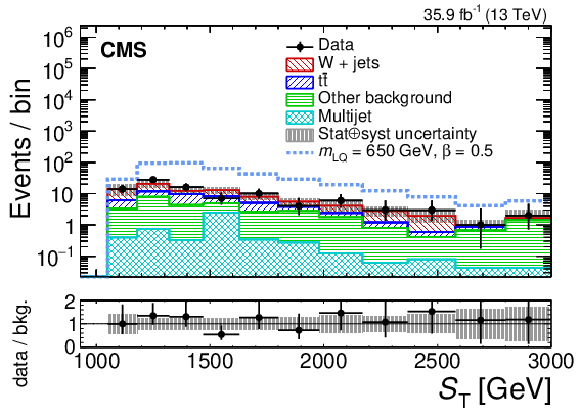
png pdf |
Figure 6-b:
$ {S_{\mathrm {T}}} $ distribution for events passing the $ {{\mathrm {e}} {\nu}\text {jj}} $ final selection for LQs of mass 650 GeV. The predicted signal model distribution is shown, along with major backgrounds and "other background'' which consists of the sum of Z/$\gamma^{*}$+jets, diboson, single top quark, and $\gamma$+jets contributions. The background contributions are stacked, while the signal distribution is plotted unstacked. The dark shaded region indicates the statistical and systematic uncertainty in the total background. The last bin includes all events beyond the upper $x$-axis boundary. |
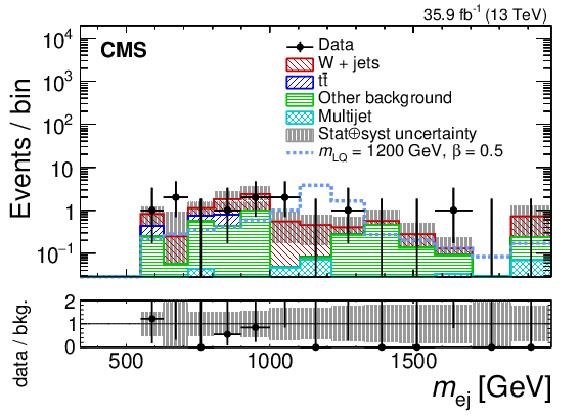
png pdf |
Figure 6-c:
$ {m_{{\mathrm {e}}\text {j}}} $ distribution for events passing the $ {{\mathrm {e}} {\nu}\text {jj}} $ final selection for LQs of mass 1200 GeV. The predicted signal model distribution is shown, along with major backgrounds and "other background'' which consists of the sum of Z/$\gamma^{*}$+jets, diboson, single top quark, and $\gamma$+jets contributions. The background contributions are stacked, while the signal distribution is plotted unstacked. The dark shaded region indicates the statistical and systematic uncertainty in the total background. The last bin includes all events beyond the upper $x$-axis boundary. |

png pdf |
Figure 6-d:
$ {S_{\mathrm {T}}} $ distribution for events passing the $ {{\mathrm {e}} {\nu}\text {jj}} $ final selection for LQs of mass 1200 GeV. The predicted signal model distribution is shown, along with major backgrounds and "other background'' which consists of the sum of Z/$\gamma^{*}$+jets, diboson, single top quark, and $\gamma$+jets contributions. The background contributions are stacked, while the signal distribution is plotted unstacked. The dark shaded region indicates the statistical and systematic uncertainty in the total background. The last bin includes all events beyond the upper $x$-axis boundary. |

png pdf |
Figure 7:
Data, background, and expected signal yields after applying the final selection criteria for the $ {{\mathrm {e}} {\mathrm {e}}\text {jj}} $ (left) and $ {{\mathrm {e}} {\nu}\text {jj}} $ (right) channels. "Other background" includes diboson, single top quark, and W+jets (for the $ {{\mathrm {e}} {\mathrm {e}}\text {jj}} $ channel) or Z/$\gamma^{*}$+jets (for the $ {{\mathrm {e}} {\nu}\text {jj}} $ channel). The bin contents are correlated, because events selected for higher-mass LQ searches are a subset of those selected for lower mass searches. |
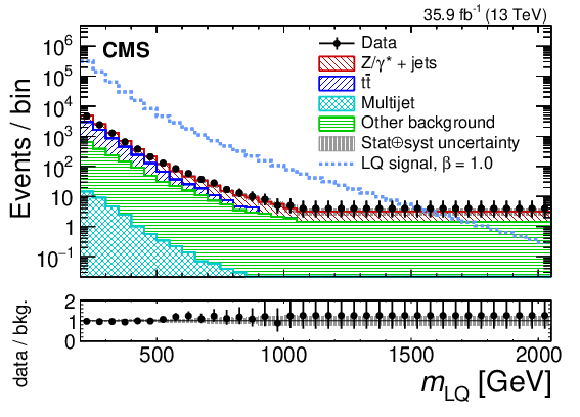
png pdf |
Figure 7-a:
Data, background, and expected signal yields after applying the final selection criteria for the $ {{\mathrm {e}} {\mathrm {e}}\text {jj}} $ channel. "Other background" includes diboson, single top quark, and W+jets (for the $ {{\mathrm {e}} {\mathrm {e}}\text {jj}} $ channel) or Z/$\gamma^{*}$+jets (for the $ {{\mathrm {e}} {\nu}\text {jj}} $ channel). The bin contents are correlated, because events selected for higher-mass LQ searches are a subset of those selected for lower mass searches. |
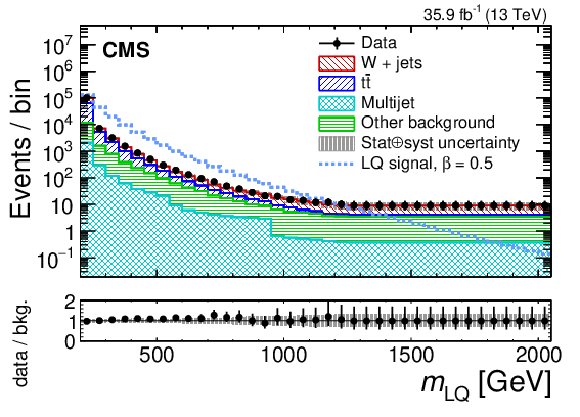
png pdf |
Figure 7-b:
Data, background, and expected signal yields after applying the final selection criteria for the $ {{\mathrm {e}} {\nu}\text {jj}} $ channel. "Other background" includes diboson, single top quark, and W+jets (for the $ {{\mathrm {e}} {\mathrm {e}}\text {jj}} $ channel) or Z/$\gamma^{*}$+jets (for the $ {{\mathrm {e}} {\nu}\text {jj}} $ channel). The bin contents are correlated, because events selected for higher-mass LQ searches are a subset of those selected for lower mass searches. |

png pdf |
Figure 8:
Observed upper limits for scalar LQ pair-production cross section times $\beta ^2$ (left) and $\beta (1{-}\beta)$ (right) at 95% CL obtained with the $ {{\mathrm {e}} {\mathrm {e}}\text {jj}} $ (left) and $ {{\mathrm {e}} {\nu}\text {jj}} $ (right) analysis. The median (dashed line), 68% (inner green band) and 95% (outer yellow band) confidence-interval expected limits are also shown. |

png pdf |
Figure 8-a:
Observed upper limits for scalar LQ pair-production cross section times $\beta ^2$ at 95% CL obtained with the $ {{\mathrm {e}} {\mathrm {e}}\text {jj}} $ analysis. The median (dashed line), 68% (inner green band) and 95% (outer yellow band) confidence-interval expected limits are also shown. |
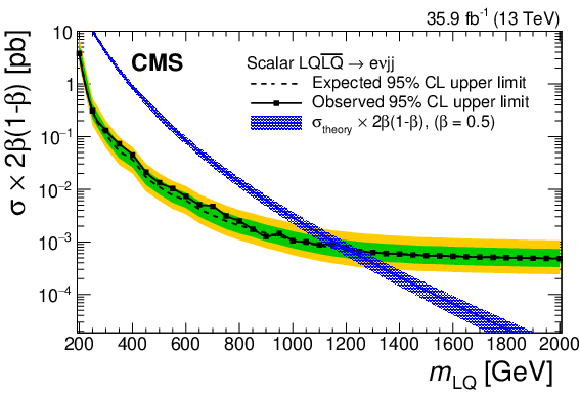
png pdf |
Figure 8-b:
Observed upper limits for scalar LQ pair-production cross section times $\beta (1{-}\beta)$ at 95% CL obtained with the $ {{\mathrm {e}} {\nu}\text {jj}} $ analysis. The median (dashed line), 68% (inner green band) and 95% (outer yellow band) confidence-interval expected limits are also shown. |

png pdf |
Figure 9:
Expected and observed exclusion limits at 95% CL for pair production of first-generation scalar LQ shown in the $\beta $ versus $ {m_{\text {LQ}}} $ plane for the individual $ {{\mathrm {e}} {\mathrm {e}}\text {jj}} $ and $ {{\mathrm {e}} {\nu}\text {jj}} $ channels and their combination. The inner green and outer yellow bands represent the 68% and 95% confidence intervals on the expected limits. |

png pdf |
Figure 10:
Expected and observed upper limits at 95% CL on the RPV SUSY $ {\tilde{\mathrm {t}}} $ squark pair production cross section as a function of $M_{{\tilde{\mathrm {t}}}}$ for $c\tau =$ 0 cm. The expected limits represent the median values, while the inner green and outer yellow bands are the 68% and 95% confidence intervals, respectively. |

png pdf |
Figure 11:
The product of signal acceptance and efficiency after final optimized selections, as a function of $ {m_{\text {LQ}}} $ for the $ {{\mathrm {e}} {\mathrm {e}}\text {jj}} $ (left) and $ {{\mathrm {e}} {\nu}\text {jj}} $ (right) channels. |
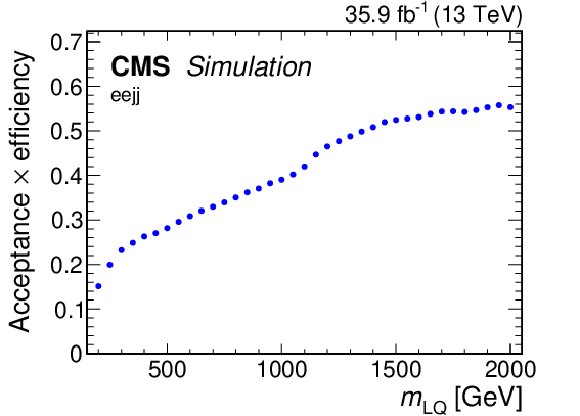
png pdf |
Figure 11-a:
The product of signal acceptance and efficiency after final optimized selections, as a function of $ {m_{\text {LQ}}} $ for the $ {{\mathrm {e}} {\mathrm {e}}\text {jj}} $ channel. |

png pdf |
Figure 11-b:
The product of signal acceptance and efficiency after final optimized selections, as a function of $ {m_{\text {LQ}}} $ for the $ {{\mathrm {e}} {\nu}\text {jj}} $ channel. |
| Tables | |

png pdf |
Table 1:
Systematic uncertainties for the $ {{\mathrm {e}} {\mathrm {e}}\text {jj}} $ and $ {{\mathrm {e}} {\nu}\text {jj}} $ channels. The values shown are calculated for the selections used in the $ {m_{\text {LQ}}} = $ 1000 GeV search hypothesis and reflect the variations in the event yields due to each source. Major backgrounds, namely Z/$\gamma^{*}$+jets \ ($ {{\mathrm {e}} {\mathrm {e}}\text {jj}} $), W+jets and $ {{\mathrm {t}\overline {\mathrm {t}}}} $ ($ {{\mathrm {e}} {\nu}\text {jj}} $), are normalized at the initial selection level when calculating the effect of shifts for various systematics. |

png pdf |
Table 2:
Event yields after the optimized ${{\mathrm {e}} {\mathrm {e}}\text {jj}} $ selections. Uncertainties are statistical except for the total background, where both statistical and systematic uncertainties are shown. An entry of 0.0 quoted for the uncertainty indicates that its value is negligibly small. LQ masses are given in units of GeV and init. sel. refers to initial selection. |

png pdf |
Table 3:
Event yields after the optimized ${{\mathrm {e}} {\nu}\text {jj}} $ selections. Uncertainties are statistical except for the total background, where both statistical and systematic uncertainties are shown. An entry of 0.0 quoted for the uncertainty indicates that its value is negligibly small. LQ masses are given in units of GeV and init. sel. refers to initial selection. |
| Summary |
| A search has been performed for the pair production of first-generation scalar leptoquarks in final states consisting of two high-momentum electrons and two jets, or one electron, large missing transverse momentum and two jets. The data sample used in the study corresponds to an integrated luminosity of 35.9 fb$^{-1}$ recorded by the CMS experiment at $\sqrt{s} = $ 13 TeV. The data are found to be in agreement with standard model background expectations and a lower limit at 95% confidence level is set on the scalar leptoquark mass at 1435 (1270) GeV for $\beta=$ 1.0 (0.5), where $\beta$ is the branching fraction of the leptoquark decay to an electron and a quark. These results constitute the most stringent limits on the mass of first-generation scalar leptoquarks to date. The data are also interpreted in the context of an $R$-parity violating supersymmetric model with promptly decaying top squarks, which can decay into leptoquark-like final states. Top squarks are excluded for masses below 1100 GeV. |
| References | ||||
| 1 | S. L. Glashow | Partial-symmetries of weak interactions | NP 22 (1961) 579 | |
| 2 | S. Weinberg | A model of leptons | PRL 19 (1967) 1264 | |
| 3 | A. Salam | Weak and electromagnetic interactions | in Elementary particle physics: relativistic groups and analyticity, Proceedings of the eighth Nobel symposium, 1968 | |
| 4 | J. C. Pati and A. Salam | Unified lepton-hadron symmetry and a gauge theory of the basic interactions | PRD 8 (1973) 1240 | |
| 5 | J. C. Pati and A. Salam | Lepton number as the fourth color | PRD 10 (1974) 275 | |
| 6 | H. Georgi and S. Glashow | Unity of all elementary-particle forces | PRL 32 (1974) 438 | |
| 7 | H. Murayama and T. Yanagida | A viable SU(5) GUT with light leptoquark bosons | MPLA 7 (1992) 147 | |
| 8 | H. Fritzsch and P. Minkowski | Unified interactions of leptons and hadrons | Annals Phys. 93 (1975) 193 | |
| 9 | G. Senjanović and A. Sokorac | Light leptoquarks in SO(10) | Z. Phys. C 20 (1983) 255 | |
| 10 | P. H. Frampton and B.-H. Lee | SU(15) grand unification | PRL 64 (1990) 619 | |
| 11 | P. H. Frampton and T. W. Kephart | Higgs sector and proton decay in SU(15) grand unification | PRD 42 (1990) 3892 | |
| 12 | S. Dimopoulos and L. Susskind | Mass without scalars | NPB 155 (1979) 237 | |
| 13 | S. Dimopoulos | Technicoloured signatures | NPB 168 (1980) 69 | |
| 14 | E. Eichten and K. Lane | Dynamical breaking of weak interaction symmetries | PLB 90 (1980) 125 | |
| 15 | J. L. Hewett and T. G. Rizzo | Low-energy phenomenology of superstring-inspired E$ _{6} $ models | PR 183 (1989) 193 | |
| 16 | B. Schrempp and F. Schrempp | Light leptoquarks | PLB 153 (1985) 101 | |
| 17 | W. Buchmuller, R. Ruckl, and D. Wyler | Leptoquarks in lepton-quark collisions | PLB 191 (1987) 442 | |
| 18 | W. Buchmuller and D. Wyler | Constraints on SU(5)-type leptoquarks | PLB 177 (1986) 377 | |
| 19 | O. Shanker | $ \pi\ell $2, $ \mathrm{K}\ell $3, and $ \mathrm{K}^0 $-$ \overline{\mathrm{K}}^0 $ constraints on leptoquarks and supersymmetric particles | NPB 204 (1982) 375 | |
| 20 | LHCb Collaboration | Measurement of form-factor-independent observables in the decay $ \mathrm{B}^{0}\to\mathrm{K}^{*0}\mu^{+}\mu^{-} $ | PRL 111 (2013) 191801 | 1308.1707 |
| 21 | LHCb Collaboration | Test of lepton universality using $ \mathrm{B^{+}}\to \mathrm{K^{+}}\ell^{+}\ell^{-} $ decays | PRL 113 (2014) 151601 | 1406.6482 |
| 22 | LHCb Collaboration | Angular analysis of the $ \mathrm{B}^{0}\to\mathrm{K}^{*0}\mu^{+} \mu^{-} $ decay using 3 fb$ ^{-1} $ of integrated luminosity | JHEP 02 (2016) 104 | 1512.04442 |
| 23 | LHCb Collaboration | Test of lepton universality with $ \mathrm{B}^{0}\to \mathrm{K}^{*0}\ell^{+}\ell^{-} $ decays | JHEP 08 (2017) 055 | 1705.05802 |
| 24 | Belle Collaboration | Lepton-flavor-dependent angular analysis of $ \mathrm{B}\to\mathrm{K}^{*} \ell^+\ell^- $ | PRL 118 (2017) 111801 | 1612.05014 |
| 25 | G. Hiller | Lepton nonuniversality anomalies and implications | in 53rd Rencontres de Moriond on QCD and High Energy Interactions (Moriond QCD 2018) La Thuile, Italy, March 17-24 | 1804.02011 |
| 26 | I. Dor\vsner et al. | Physics of leptoquarks in precision experiments and at particle colliders | PR 641 (2016) 1 | 1603.04993 |
| 27 | OPAL Collaboration | Search for pair-produced leptoquarks in $ \mathrm{e}^+\mathrm{e}^- $ interactions at $ \sqrt{s}\simeq $ 189-209 GeV | EPJC 31 (2003) 281 | hep-ex/0305053 |
| 28 | ZEUS Collaboration | Search for resonance decays to lepton+jet at DESY HERA and limits on leptoquarks | PRD 68 (2003) 052004 | hep-ex/0304008 |
| 29 | H1 Collaboration | Search for first generation leptoquarks in ep collisions at HERA | PLB 704 (2011) 388 | 1107.3716 |
| 30 | CDF Collaboration | Search for first-generation scalar leptoquarks in $ {\mathrm{p}}\mathrm{\bar{p}} $ collisions at $ \sqrt{s} = $ 1.96 TeV | PRD 72 (2005) 051107 | hep-ex/0506074 |
| 31 | D0 Collaboration | Search for pair production of first-generation leptoquarks in $ {\mathrm{p}}\mathrm{\bar{p}} $ collisions at $ \sqrt{s} = $ 1.96 TeV | PLB 681 (2009) 224 | 0907.1048 |
| 32 | CMS Collaboration | Search for pair production of first and second generation leptoquarks in proton-proton collisions at $ \sqrt{s} = $ 8 TeV | PRD 93 (2016) 032004 | CMS-EXO-12-041 1509.03744 |
| 33 | CMS Collaboration | Search for single production of scalar leptoquarks in proton-proton collisions at $ \sqrt{s} = $ 8 TeV | PRD 93 (2016) 032005 | CMS-EXO-12-043 1509.03750 |
| 34 | ATLAS Collaboration | Search for scalar leptoquarks in pp collisions at $ \sqrt{s} = $ 13 TeV with the ATLAS experiment | New J. Phys. 18 (2016) 093016 | 1605.06035 |
| 35 | M. Kramer, T. Plehn, M. Spira, and P. M. Zerwas | Pair production of scalar leptoquarks at the CERN LHC | PRD 71 (2005) 057503 | hep-ph/0411038 |
| 36 | CMS Collaboration | The CMS trigger system | JINST 12 (2017) P01020 | CMS-TRG-12-001 1609.02366 |
| 37 | CMS Collaboration | The CMS experiment at the CERN LHC | JINST 3 (2008) S08004 | CMS-00-001 |
| 38 | T. Sjostrand et al. | An introduction to PYTHIA 8.2 | CPC 191 (2015) 159 | 1410.3012 |
| 39 | R. D. Ball et al. | Parton distributions with LHC data | NPB 867 (2013) 244 | 1207.1303 |
| 40 | M. Kramer, T. Plehn, M. Spira, and P. M. Zerwas | Pair production of scalar leptoquarks at the Fermilab Tevatron | PRL 79 (1997) 341 | hep-ph/9704322 |
| 41 | J. Pumplin et al. | New generation of parton distributions with uncertainties from global QCD analysis | JHEP 07 (2002) 012 | hep-ph/0201195 |
| 42 | J. Alwall et al. | The automated computation of tree-level and next-to-leading order differential cross sections, and their matching to parton shower simulations | JHEP 07 (2014) 079 | 1405.0301 |
| 43 | R. Frederix and S. Frixione | Merging meets matching in MC@NLO | JHEP 12 (2012) 061 | 1209.6215 |
| 44 | P. Artoisenet, R. Frederix, O. Mattelaer, and R. Rietkerk | Automatic spin-entangled decays of heavy resonances in Monte Carlo simulations | JHEP 03 (2013) 015 | 1212.3460 |
| 45 | P. Nason | A new method for combining NLO QCD with shower Monte Carlo algorithms | JHEP 11 (2004) 040 | hep-ph/0409146 |
| 46 | S. Frixione, P. Nason, and C. Oleari | Matching NLO QCD computations with parton shower simulations: the POWHEG method | JHEP 11 (2007) 070 | 0709.2092 |
| 47 | S. Alioli, P. Nason, C. Oleari, and E. Re | A general framework for implementing NLO calculations in shower Monte Carlo programs: the POWHEG BOX | JHEP 06 (2010) 043 | 1002.2581 |
| 48 | S. Alioli, P. Nason, C. Oleari, and E. Re | NLO single-top production matched with shower in POWHEG: $ s $- and $ t $-channel contributions | JHEP 09 (2009) 111 | 0907.4076 |
| 49 | E. Re | Single-top Wt-channel production matched with parton showers using the POWHEG method | EPJC 71 (2011) 1547 | 1009.2450 |
| 50 | S. Frixione, P. Nason, and G. Ridolfi | A positive-weight next-to-leading-order Monte Carlo for heavy flavour hadroproduction | JHEP 09 (2007) 126 | 0707.3088 |
| 51 | J. Alwall et al. | Comparative study of various algorithms for the merging of parton showers and matrix elements in hadronic collisions | EPJC 53 (2008) 473 | 0706.2569 |
| 52 | NNPDF Collaboration | Parton distributions for the LHC Run II | JHEP 04 (2015) 040 | 1410.8849 |
| 53 | Y. Li and F. Petriello | Combining QCD and electroweak corrections to dilepton production in FEWZ | PRD 86 (2012) 094034 | 1208.5967 |
| 54 | M. Aliev et al. | HATHOR: hadronic top and heavy quarks cross section calculator | CPC 182 (2011) 1034 | 1007.1327 |
| 55 | P. Kant et al. | HATHOR for single top-quark production: updated predictions and uncertainty estimates for single top-quark production in hadronic collisions | CPC 191 (2015) 74 | 1406.4403 |
| 56 | N. Kidonakis | Top quark production | in Helmholtz International Summer School on Physics of Heavy Quarks and Hadrons (HQ 2013): JINR, Dubna, Russia, July 15-28 | 1311.0283 |
| 57 | M. Beneke, P. Falgari, S. Klein, and C. Schwinn | Hadronic top-quark pair production with NNLL threshold resummation | NPB 855 (2012) 695 | 1109.1536 |
| 58 | M. Cacciari et al. | Top-pair production at hadron colliders with next-to-next-to-leading logarithmic soft-gluon resummation | PLB 710 (2012) 612 | 1111.5869 |
| 59 | P. Barnreuther, M. Czakon, and A. Mitov | Percent-level-precision physics at the Tevatron: next-to-next-to-leading order QCD corrections to $ \mathrm{q\bar{q}}\to\mathrm{t\bar{t}} + {\rm x} $ | PRL 109 (2012) 132001 | 1204.5201 |
| 60 | M. Czakon and A. Mitov | NNLO corrections to top-pair production at hadron colliders: the all-fermionic scattering channels | JHEP 12 (2012) 054 | 1207.0236 |
| 61 | M. Czakon and A. Mitov | NNLO corrections to top pair production at hadron colliders: the quark-gluon reaction | JHEP 01 (2013) 080 | 1210.6832 |
| 62 | M. Czakon, P. Fiedler, and A. Mitov | Total top-quark pair-production cross section at hadron colliders through $ {\cal O}(\alpha^4_{S}) $ | PRL 110 (2013) 252004 | 1303.6254 |
| 63 | M. Czakon and A. Mitov | Top++: A program for the calculation of the top-pair cross-section at hadron colliders | CPC 185 (2014) 2930 | 1112.5675 |
| 64 | CMS Collaboration | Event generator tunes obtained from underlying event and multiparton scattering measurements | EPJC 76 (2016) 155 | CMS-GEN-14-001 1512.00815 |
| 65 | CMS Collaboration | Investigations of the impact of the parton shower tuning in PYTHIA 8 in the modelling of $ \mathrm{t\overline{t}} $ at $ \sqrt{s}= $ 8 and 13 TeV | CMS-PAS-TOP-16-021 | CMS-PAS-TOP-16-021 |
| 66 | GEANT4 Collaboration | GEANT4--a simulation toolkit | NIMA 506 (2003) 250 | |
| 67 | J. Allison et al. | GEANT4 developments and applications | IEEE Trans. Nucl. Sci. 53 (2006) 270 | |
| 68 | CMS Collaboration | Particle-flow reconstruction and global event description with the CMS detector | JINST 12 (2017) P10003 | CMS-PRF-14-001 1706.04965 |
| 69 | CMS Collaboration | Performance of electron reconstruction and selection with the CMS detector in proton-proton collisions at $ \sqrt{s} = $ 8 TeV | JINST 10 (2015) P06005 | CMS-EGM-13-001 1502.02701 |
| 70 | M. Cacciari, G. P. Salam, and G. Soyez | The anti-$ {k_{\mathrm{T}}} $ jet clustering algorithm | JHEP 04 (2008) 063 | 0802.1189 |
| 71 | M. Cacciari, G. P. Salam, and G. Soyez | FastJet user manual | EPJC 72 (2012) 1896 | 1111.6097 |
| 72 | CMS Collaboration | Performance of the CMS muon detector and muon reconstruction with proton-proton collisions at $ \sqrt{s}= $ 13 TeV | JINST 13 (2018) P06015 | CMS-MUO-16-001 1804.04528 |
| 73 | CMS Collaboration | Jet algorithms performance in 13 TeV data | CMS-PAS-JME-16-003 | CMS-PAS-JME-16-003 |
| 74 | CMS Collaboration | Jet energy scale and resolution in the CMS experiment in pp collisions at 8 TeV | JINST 12 (2017) P02014 | CMS-JME-13-004 1607.03663 |
| 75 | CMS Collaboration | Performance of missing transverse momentum reconstruction algorithms in proton-proton collisions at $ \sqrt{s} = $ 8 TeV with the CMS detector | CMS-PAS-JME-12-002 | CMS-PAS-JME-12-002 |
| 76 | CMS Collaboration | Identification of heavy-flavour jets with the CMS detector in pp collisions at 13 TeV | JINST 13 (2018) P05011 | CMS-BTV-16-002 1712.07158 |
| 77 | G. Punzi | Sensitivity of searches for new signals and its optimization | in PHYSTAT 2003: Statistical problems in particle physics, astrophysics and cosmology Stanford, USA, September, 2003 [Conference C03-09-08] | physics/0308063 |
| 78 | CMS Collaboration | Performance of photon reconstruction and identification with the CMS detector in proton-proton collisions at $ \sqrt{s} = $ 8 TeV | JINST 10 (2015) P08010 | CMS-EGM-14-001 1502.02702 |
| 79 | CMS Collaboration | Measurements of inclusive W and Z cross sections in pp collisions at $ \sqrt{s}= $ 7 TeV | JHEP 01 (2011) 080 | CMS-EWK-10-002 1012.2466 |
| 80 | CMS Collaboration | CMS luminosity measurements for the 2016 data taking period | CMS-PAS-LUM-17-001 | CMS-PAS-LUM-17-001 |
| 81 | CMS Collaboration | Measurement of the inelastic proton-proton cross section at $ \sqrt{s}= $ 13 TeV | JHEP 07 (2018) 161 | CMS-FSQ-15-005 1802.02613 |
| 82 | M. Botje et al. | The PDF4LHC Working Group Interim Recommendations | 1101.0538 | |
| 83 | S. Alekhin et al. | The PDF4LHC Working Group Interim Report | 1101.0536 | |
| 84 | M. R. Whalley, D. Bourilkov, and R. C. Group | The Les Houches accord PDFs (LHAPDF) and LHAGLUE | in HERA and the LHC: A Workshop on the implications of HERA for LHC physics. Proceedings, Part B 2005 | hep-ph/0508110 |
| 85 | D. Bourilkov, R. C. Group, and M. R. Whalley | LHAPDF: PDF use from the Tevatron to the LHC | in TeV4LHC Workshop - 4th meeting Batavia, Illinois, October 20-22 | hep-ph/0605240 |
| 86 | G. Cowan, K. Cranmer, E. Gross, and O. Vitells | Asymptotic formulae for likelihood-based tests of new physics | EPJC 71 (2011) 1554 | 1007.1727 |
| 87 | T. Junk | Confidence level computation for combining searches with small statistics | NIMA 434 (1999) 435 | hep-ex/9902006 |
| 88 | A. L. Read | Presentation of search results: the CLs technique | JPG 28 (2002) 2693 | |
| 89 | The ATLAS Collaboration, The CMS Collaboration, The LHC Higgs Combination Group | Procedure for the LHC Higgs boson search combination in Summer 2011 | CMS NOTE-2011/005, ATL-PHYS-PUB-2011-11 | |
| 90 | H. K. Dreiner | An introduction to explicit $ R $-parity violation | Pramana 51 (1998) 123 | |
| 91 | R. Barbier et al. | $ R $-parity-violating supersymmetry | PR 420 (2005) 1 | hep-ph/0406039 |

|
Compact Muon Solenoid LHC, CERN |

|

|

|

|

|

|